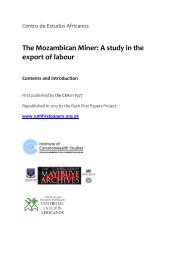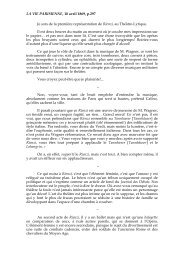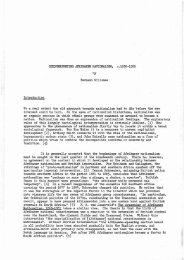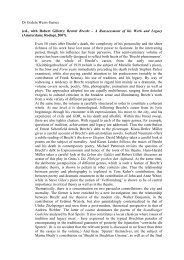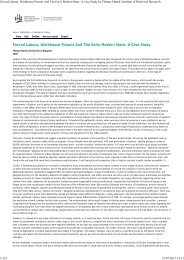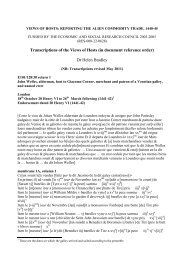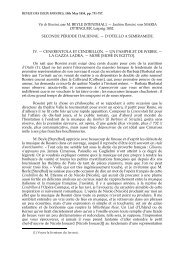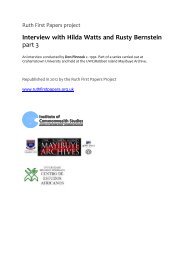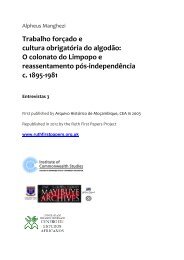Roraima: Brazil's northernmost frontier by John Hemming - SAS-Space
Roraima: Brazil's northernmost frontier by John Hemming - SAS-Space
Roraima: Brazil's northernmost frontier by John Hemming - SAS-Space
You also want an ePaper? Increase the reach of your titles
YUMPU automatically turns print PDFs into web optimized ePapers that Google loves.
From 1976 onwards, garimpeiros periodically invaded Yanomami land,<br />
despite occasional orders forbidding such invasions. By 1984 there were<br />
prospecting garimpos involving several hundred miners on the upper Apiau<br />
river and on a tributary of the Uraricaa. Five thousand prospectors from<br />
Southern Mato Grosso reached <strong>Roraima</strong> in 1985, intent on invading<br />
Yanomami land. In February that year, an advance party of 67 miners was<br />
flown into a clandestine airstrip near Surucucus; but they were promptly<br />
removed <strong>by</strong> armed police sent <strong>by</strong> the Territory's governor. During these<br />
years, the prospectors' cause was championed <strong>by</strong> two local deputies,<br />
Mozarildo Cavalcanti and Joao Batista Fagundes, who waged a determined<br />
campaign in the National Assembly in Brasilia and the press in <strong>Roraima</strong>.<br />
Fagundes declared; T intend to diminish the immense area of <strong>Roraima</strong> that<br />
is blocked for any economic activity. For example, I find it entirely just to<br />
leave outside the reserve the Apiau garimpo, where there are 3,000 prospectors<br />
[actually 250] and no Indian for a radius of 150 kilometeres.' 65 On the<br />
opposite side, a meeting of Yanomami tribal leaders in 1984 wrote to the<br />
Indian deputy Mario Juruna: 'We, the Yanomami Indians, ask you to help us<br />
remove the prospectors from our Indian lands. The prospectors have for the<br />
past two years been invading Yanomami lands, extracting our gold, bringing<br />
diseases, coveting and taking our women, and pillaging our plantations.'<br />
Another Yanomami assembly in March 1986 reinforced the demand<br />
for the Yanomami Park to be properly demarcated and protected.<br />
In March 1982 the Minister of the Interior signed a decree 'interdicting'<br />
7,700,000 hectares that would form a future reserve for the 8,400 Yanomami<br />
living in 192 malocas in Brazil. Of this vast area, some 5 million hectares<br />
were for the 7,100 Yanomami living in <strong>Roraima</strong>, and the remainder for those<br />
living north of the Rio Negro in Amazonas. Pro-Indian groups around the<br />
world were jubilant at this apparent victory. But Claudia Andujar of the<br />
CCPY warned that this interdiction was only a first step: the Indians' champions<br />
could not relax until the Park was finally demarcated and invasions<br />
ceased. In late 1984 FUNAI redefined the Park, to bring within it a further<br />
149 Yanomami malocas and three groups of related Yekuana.<br />
In the following year 1985, the Brazilian armed forces launched the Calha<br />
Norte campaign to plant military garrisons all along <strong>Brazil's</strong> northern <strong>frontier</strong>s.<br />
Barracks were to be built and airstrips expanded at a series of strategic<br />
points, which were invariably Indian missions or FUNAI posts. The Calha<br />
Norte was never properly explained. It was said to be protection for this <strong>frontier</strong>;<br />
but there was no conceivable threat to this boundary, which had been<br />
peaceful for over two centuries. It was reported to be intended to prevent<br />
drug smuggling or the entry of subversives - as though the smugglers would<br />
try to enter Brazil across some of the toughest forests and rapid-infested rivers<br />
on earth. It was claimed that the presence of troops would bring the<br />
Indians into the mainstream of Brazilian society, a delicate process that was<br />
being done <strong>by</strong> missionaries and FUNAI officers. An explicit objective of the<br />
Calha Norte was 'to enlarge the work of FUNAI among the indigenous<br />
populations' because their farming methods were considered to be primitive



